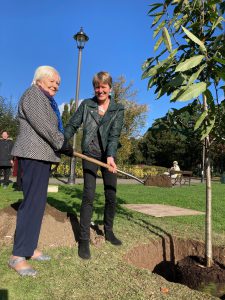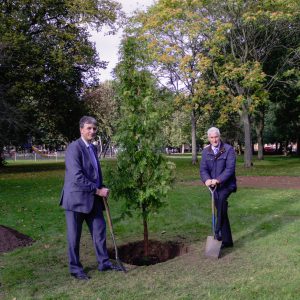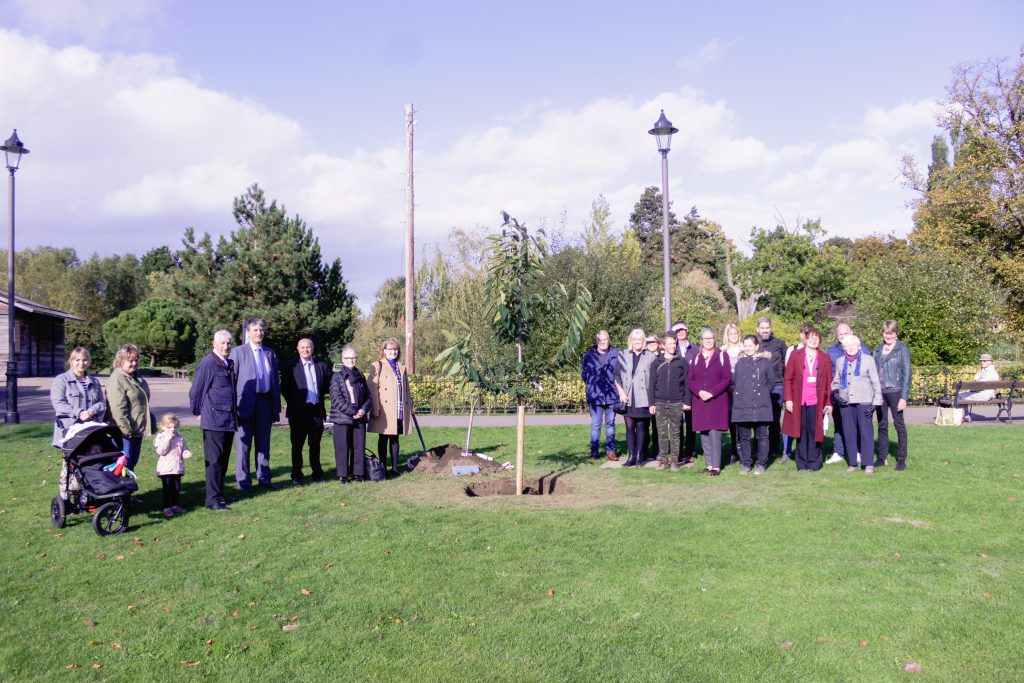North East Lincolnshire Council planted the first of eight new trees in two of its best-loved parks today to celebrate the success of a three-and-a-half-year-long carbon-cutting project.
One tree was planted in People’s Park and another in Weelsby Woods, thanks to the Smart Energy Greater Lincolnshire project. Another three trees will be planted in each park in the next few weeks.
Thanks to the project, businesses and organisations in Greater Lincolnshire saved more than 3,668 tonnes of carbon in the last three years and drastically cut their energy bills.
Smart Energy Greater Lincolnshire provided expert advice and grant funding to support projects such as changing lighting to LEDs, heating solutions such as ground source and air source heat pumps, renewable energy and solar panels, all making significant carbon and financial savings
The trees in People’s Park include a sweet chestnut, copper beech, pin oak and a red-twigged lime. More will be planted later in the year, including cherry trees to replace those that had to be removed.
The trees in Weelsby Woods include a dawn redwood, common walnut, black walnut and swamp cypress.
Both parks are conservation areas, and all the trees were chosen by arboriculturists from the Council’s regeneration services partner EQUANS to complement those already there.
Over their lifetimes, the eight trees are expected to absorb more than 45 tonnes of carbon from the atmosphere.
Councillors and council staff were joined by Pam Shreeve and her family for the ceremony.

Pam helped plant some of the cherry trees in People’s Park for the Queen’s Coronation in 1953.
Some of the trees had to be cut down in May after they were damaged by a fungus.
Pam’s daughter Rachael used offcuts of the wood to make bowls and a cross section as a keepsake for the family.
Pam met her husband Paul in People’s Park the same year as the Coronation, and they still walk around it daily with their dog Gabi.
Cllr Philip Jackson, council leader and portfolio holder for the green agenda, said:
“Today’s tree planting event celebrates the success of an innovative project that represents some of the early steps we’ve taken to cut the area’s carbon emissions.
“One of the biggest contributors to carbon emissions is the energy used to heat buildings.
“In three-and-a-half years, Smart Energy Greater Lincolnshire provided dedicated support to 260 businesses as well as energy-saving upgrades to 31 public buildings.
“One company saved more than £10,900 on its quarterly electricity bill.
“Delivered by North East Lincolnshire Council, the £8.5 million ERDF and Salix part-funded project engaged with public building owners and small and medium-sized businesses to help them in their zero-carbon journey.
“We want to set an ambitious target for the Council to be Carbon NetZero by 2040 and for the borough to be Carbon NetZero by 2050.
“Thanks to Smart Energy Greater Lincolnshire and its sustainable legacy, there is a now a greater awareness among businesses and public building owners to think long-term and do more to help the environment.”

Tree carbon statistics
In terms of carbon sequestration, Barchams provide an ‘eco tag’ for each tree. The following carbon performance rating for each tree has been taken from Barchams ‘eco tag’.
The certificate or rating of a tree is based on the amount of carbon it will absorb from the atmosphere and store within its woody tissues, over its anticipated ‘ideal’ lifespan.
- Castanea sativa (sweet chestnut): 6.854 tonnes
- Fagus sylvatica Purpurea (copper beech): 7.5 tonnes
- Quercus palustris (pin oak): 6.589 tonnes
- Tilia platyphyllos Rubra (red-twigged lime): 5.019 tonnes
- Juglans nigra (black walnut): 7.094 tonnes
- Juglans regia (common walnut): 5.337 tonnes
- Metasequoia glyptostroboides (dawn redwood): 5.09 tonnes
- Taxodium distichum Feathered (swamp cypress): 2.902 tonnes
Smart Energy Greater Lincolnshire
Smart Energy Greater Lincolnshire is a £8.5m project being run by North East Lincolnshire Council on behalf of the Greater Lincolnshire LEP in partnership with the University of Applied Sciences Trier’s Institut fur angewandtes Stroffstrommanagement (IfaS). The aim is to boost renewable energy use in small to medium enterprises, council and other public sector owned buildings in the area. The European Regional Development Fund (ERDF) awarded £5.4m for the project, which started at the beginning of April 2018 and ends on 30th September 2021. Along with private sector investment, the funding has been used to set-up a one-stop shop to provide energy and low carbon services for SMEs as well as facilitating large-scale investment in public infrastructure.
European Regional Development Fund
The project has received £5.4m of funding from the England European Regional Development Fund as part of the European Structural and Investment Funds Growth Programme 2014-2020. The Ministry of Housing, Communities and Local Government (and in London the intermediate body Greater London Authority) is the Managing Authority for European Regional Development Fund. Established by the European Union the European Regional Development Fund helps local areas stimulate their economic development by investing in projects which will support innovation, businesses, create jobs and local community regenerations. For more information visit https://www.gov.uk/european-growth-funding- external site

Share this article